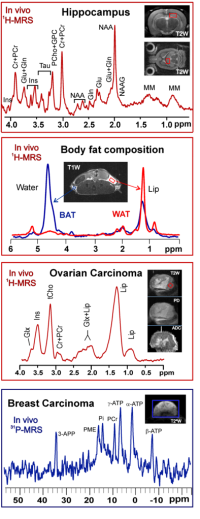NMR & MRI area
Preclinic MRI Unit
In medicine, the term Magnetic Resonance Imaging is referred to a set of techniques able to study morphological alterations or follow metabolic processes or both in living organisms. These techniques can be divided into sequences for image acquisition (imaging) and for spectroscopy study. In fact, the anatomical study with imaging (MRI) in normal and pathological conditions can be combined with magnetic resonance spectroscopy (MRS) to quantify in vivo the levels of metabolites present in organs or lesions, and to follow alterations in these levels during evolution of a pathology or in response to therapeutic treatments.
Magnetic Resonance Imaging (MRI) is an imaging technique used in medicine primarily for diagnostic purposes, based on the physical principle of nuclear magnetic resonance.
The Service will use a 7 T system for imaging and spectroscopy studies in small animals, with the availability of coils resonant at the frequencies of hydrogen (1H), phosphorus (31P) and fluorine (19F) nuclei.
The information given by the magnetic resonance images are different from those of the other imaging methods, in fact it is possible the discrimination between tissues on the basis of their biochemical composition or of the water diffusion capacity in the tissues or through the use of proper parameters of the resonance phenomenon such as T1 and T2.
Among the numerous applications of magnetic resonance, the Service of the MRI Unit offers expertise in:
- morphological imaging (MRI weighed in T1 and T2 or with the signal intensity proportional to the proton density) for anatomical studies;
- diffusion-weighted imaging that includes both diffusion tensor imaging (DTI for the determination for anatomic connectivity studies in the brain) and its trace (DWI with ADC measurement for studies on the response to drugs in oncology);
- functional imaging to study brain activation as a result of pharmacological stimuli (pharmacological MRI) and for studies of functional connectivity at rest (functional connectivity);
- in vivo spectroscopy at the frequency of the hydrogen nucleus (1H-MRS) to study the metabolism of part of an organ or tissue in vivo during the evolution of a pathology or in response to therapeutic treatments with applications, in oncology, in neuroscience and in the field of metabolic diseases;
- in vivo spectroscopy at the frequency of the phosphorus nucleus (31P-MRS) to study energy metabolism and to measure intracellular and extracellular pH for oncology studies;
- in vivo spectroscopy at the fluorine nucleus frequency (19F-MRS) to study the uptake and metabolism of fluorinated drugs.
To ask for the service:
- preliminary contact the preclinic MRI unit staff;
- fill out the online form 'Service Request' briefly illustrating the scientific problem;
- plan a meeting with the unit staff to discuss methods, costs, timing etc.
Contact: Rossella Canese
☎ +39 06 4990 2567

